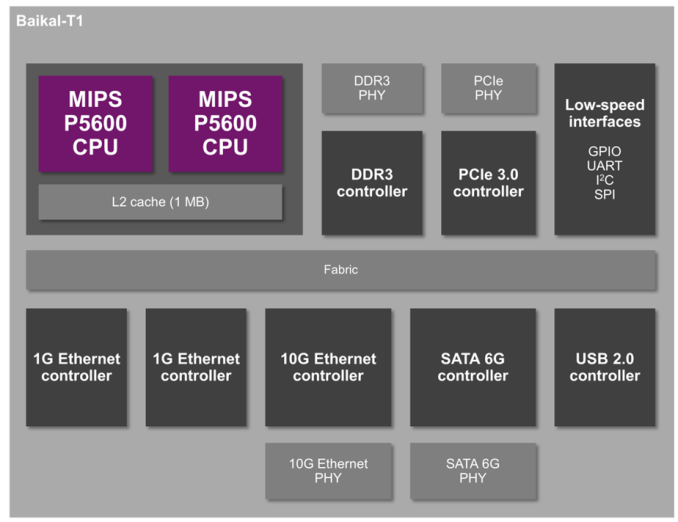Spot the CPU: Russian Baikal-T1 SoC Goes MIPS
by Ian Cutress on May 27, 2015 11:00 AM EST- Posted in
- SoCs
- CPUs
- Imagination Technologies
- MIPS
- Baikal

If you keep your ear to the ground with the technology press, you can’t help but notice a few news stories hitting the ground when it comes to Russia, and a slow progression away from x86 relying on home-grown silicon for enterprise applications. These stories have to be taken with a grain of salt, as sometimes the sources are not the best. However one of our more regular sources of news, Imagination Technologies, has lifted the lid on a press release regarding the implementation of MIPS into a communications based SoC with a Russian fabless semiconductor company.
The SoC at the heart of today’s press release is the Baikal-T1, which uses the dual core MIPS P5600 Warrior CPU at its base, clocked at 1.2 GHz but supporting a fabric that also integrates dual gigabit Ethernet, 10 gigabit Ethernet, SATA 6 Gbps, DDR3 and PCIe 3.0 at once. The 25x25nm package is manufactured on 28nm (TSMC we would assume) for a sub-5W power consumption.
In a world where we discuss smartphone, tablet and notebook SoCs moving to 64-bit, perhaps linking back in to a 32-bit core seems like a regression. Imagination is keen to point out their Enhanced Virtual Addressing for 4GB use and Extended Physical Addressing for 1TB technologies help on this front, as well as enhanced instruction bonding featured in recent generations of Imagination MIPS.
So perhaps a 5W communications processor is not that exciting but it sets a small precedent here. Most of our readers are situated in the west, where x86 and ARM are the key players in anything above 1W. Security concerns regarding backdoor implementations in both designs and algorithms are causing two of the world’s largest superpowers, Russia and China, to pursue other avenues, even if this is via the government or commercial. On the commercial line, nation states will offer contracts to those who can satisfy the criteria, and if the criteria is non-x86 + non-ARM to avoid potential issues, especially when it comes to networking, then commercial will come in to fill the void. To that extent, ELVEES, another Russian SoC semiconductor company, is already using 32-bit and 64-bit MIPS in their designs for video analytics.
Source: Imagination Technologies





_thumb.png)








26 Comments
View All Comments
Michael Bay - Thursday, May 28, 2015 - link
If you believe that some firewall may restrict THINKING, you have far bigger problems than chineese people.toyotabedzrock - Wednesday, May 27, 2015 - link
Who gets to tell them the bad news of where MIPS was developed?lilo777 - Wednesday, May 27, 2015 - link
Why would you think "they" need to be told? Don't they already know? For example, they could simply read about MIPS on Russian Wikipedia (https://ru.wikipedia.org/wiki/MIPS_(%D0%B0%D1%80%D...Obviouslky you are not the first westerner who got concerned about telling "them" what they need to know. And the answer is - US State Department and USAID. With combined annual budget of more than $50B the primary goal of these organizations is to tell "them" how they are supposed to live.
Dmcq - Wednesday, May 27, 2015 - link
I thought Baikal were also doing their own ARM chip which gets rid of the 'potential issues' with that. Or have they given up on that?Achtung_BG - Thursday, May 28, 2015 - link
I think Elbrus processor is also very interesting .http://www.extremetech.com/computing/205463-shadow...
Russian foundries lags 8-10 years behind the leader Intel . Micron started 65nm wafer of 200 mm last year and angstrem using 90nm process.
znajit - Thursday, January 27, 2022 - link
Russia lags semi both in design and fab foundries. Sad to see so much good talent leave Russia to find work in the west. Still there MIPS and RISC under development are interesting even though they lag there wester and in particular the US - I cant see them catching-up to likes of AMD/Nvidia and use there chips in future homegrown Supper computers. If sanctions kick in, there dreams of leading the AI, which req more custom chips Vs SIMD/VLIW will cause further lag. Maybe they thinking is that China will have nm fab facilities and Russians can get the latest Chines processors without spending much of there Gas/Oil wealth on smi research.No pain no gain